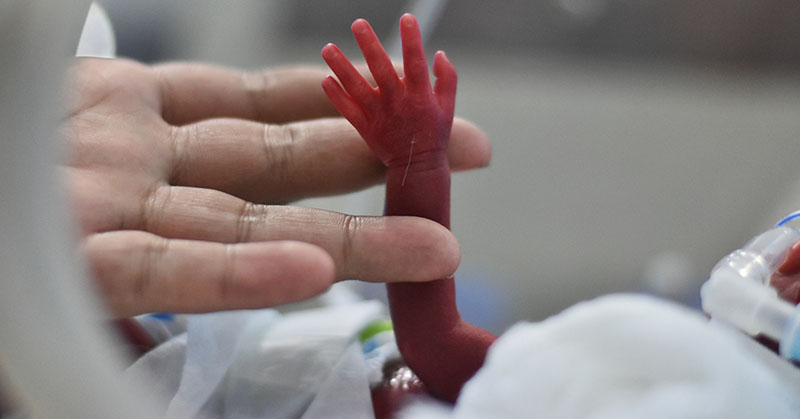
Children born preterm who underwent several painful medical procedures in early life may be at high risk for autism spectrum disorders and lower motor and language scores at 18 months of age, suggests a study funded by the National Institutes of Health. MRI scans on a subset of infants in the study revealed that they had a higher degree of activity between brain regions that receive and interpret pain messages. The authors concluded that repeated exposure to pain may affect early brain development and that their findings underscore the need to develop more effective pain management procedures for preterm infants.
The study was conducted by Kevin Cook, Ph.D., and Catherine Limperopoulos, Ph.D., of Children’s National Hospital, and their colleagues. It appears in BMC Medicine. NIH funding was provided by the Eunice Kennedy Shriver National Institute of Child Health and Human Development and National Heart, Lung, and Blood Institute.
Background
Infants born very preterm (before 32 weeks of pregnancy) and extremely preterm (before 28 weeks) are at risk for developmental delays affecting movement and coordination, language, and cognition. They are also at risk for autism spectrum disorder (ASD).
Reasons for these heightened risks are not known, the authors wrote. They added that one possibility is that the brains of preterm infants develop differently outside the womb than inside the womb. Although the brains of preterm infants increase in size as they mature, their brain volume tends to be less than that of infants born at term. They noted that, compared to the environment inside the uterus, the newborn intensive care units (NICUs) where preterm infants are treated have bright lights and loud noises, which could affect their developing nervous systems. A previous study found that rates of ASD and other neurodevelopmental disorders are higher among children who stayed in a NICU, even among term infants. Infants who stay in the NICU may also have numerous painful procedures, such as frequent heel sticks and vein punctures for blood samples. Most are performed without anesthesia.
For the current study, researchers examined how skin breaks from needle sticks in the NICU might influence brain development of children born very preterm and extremely preterm when they reached 18 months corrected age—the age they would have been 18 months old, had they been born at term. The researchers evaluated 148 children born very or extremely preterm and 99 healthy infants born at term after uncomplicated pregnancies. Children were assessed with the Modified Checklist for Autism in Toddlers-Revised, a 20-item screening tool for risk of ASD and the Mullen Scales of Early Learning, which encompasses gross and fine motor, visual, and language development. They also underwent MRI scans of their brains.
Results
Children identified as at risk for ASD experienced an average of roughly 118 skin breaks, compared to roughly 65 skin breaks among those not at risk. More skin breaks at younger weeks of gestation correlated with higher risk of ASD. Term infants tended to have larger brain volumes than preterm infants, but the investigators found no difference in volume related to skin break procedures. However, the number of skin break procedures correlated with differences in functional connectivity—a measure of interactions inside and between brain regions. Very and extremely preterm infants who had a high number of skin breaks tended to have increased connectivity within the cerebellum, a brain region that coordinates movement and is involved in pain perception. Children with a higher number of skin breaks also had higher functional connectivity between the cerebellum and the limbic and paralimbic systems—also involved with pain perception. Higher numbers of skin breaks in preterm infants were also associated with deficits in motor skills and expressive (spoken) language.
Significance
The authors noted that the increased functional connectivity they observed among preterm infants with a higher number of skin breaks is similar to the higher connectivity in corresponding brain regions of adults with chronic pain. Moreover, the higher connectivity associated with skin breaks in preterm infants was also linked with higher risk scores for ASD and deficits in motor skills and expressive language.
The authors noted that other aspects of the newborn intensive care experience could account for at least some of the neurodevelopmental differences they observed in their study. These include other aspects of the intensive care environment, such as bright lighting and loud noises or health conditions affecting preterm infants that resulted in their need for intensive care. However, the findings underscore the need to anticipate that painful procedures could have an effect on the neurodevelopment of preterm infants. These findings also suggest that new procedures may need to be developed to treat pain in this group of infants.
Next Steps
The authors plan to re-evaluate the children in their study through toddlerhood and into early childhood. They also called for larger studies to verify their findings and to investigate other aspects of the newborn intensive care experience that could influence neurodevelopment.
Reference
Cook, KM, et al. Experience of early‑life pain in premature infants is associated with atypical cerebellar development and later neurodevelopmental deficits. BMC Medicine. 2023. https://doi.org/10.1186/s12916-023-03141-w


 BACK TO TOP
BACK TO TOP